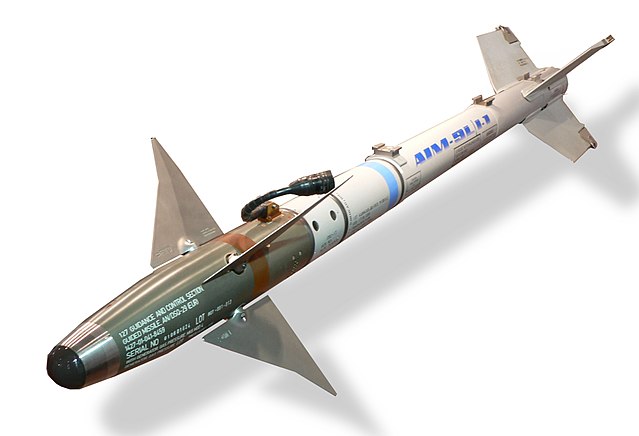
How does a heat-seeking missile work? By detecting and homing in on the infrared radiation released by a plane.
Heat-seeking missiles are either launched from a plane or from the ground. They lock onto a target plane, correct their course as they track the plane, and then detonate either when they hit the target or when they get near to it. They are called heat-seeking, but they are actually infrared radiation seeking missiles.
Infrared radiation is the region of the electromagnetic radiation spectrum between 750 nanometers and 1 millimeter. It is just beyond the part of the spectrum that we can see as visible light. Most human eyes cannot see much beyond 700 nanometers. Infrared radiation is given off when something is heated up. When you apply heat to something, it gives the atoms more energy and their electrons move to another orbit. They can’t stay there forever and when they drop back to the previous orbit, they release the energy as infrared radiation. We can’t see infrared, but many animals can. We can also buy cameras that can see infrared radiation. If you steal something and run into a forest, the police will use an infrared camera so they can see the heat you are giving off, even through the tree canopy. This infrared radiation is what the heat-seeking missile locks on to.
The missile comprises four parts. It has a solid fuel booster, which is designed to accelerate the rocket extremely quickly to Mach 2.5 or higher. There are no regular planes that can outrun a missile. Then it has the explosive. This will either explode on impact or will have a fuse programmed to set it off when it is a certain, and deadly distance from the target. The missile has the infrared radiation detector in its nosecone, and it has fins at the back that can be angled by the onboard computer, changing the missile’s trajectory.
In the nosecone of the rocket is an infrared detector. There are several different materials that can be used to detect infrared radiation. The detector uses a series of lenses and mirrors that direct any incoming infrared radiation onto the detector, which converts it into an electrical signal. The detector in the nosecone is able to rotate, allowing it to scan large sections of the sky. The detector also has filters to block out the frequencies of wavelength that are most commonly found in background radiation. The biggest source of infrared radiation is the sun and the second largest source is radiation reflecting off the Earth. The missile would be no use if it was attracted to these, so they are filtered out.
Once the missile is fired, it picks up the infrared radiation coming from the target plane. Modern planes are built to give off as little radiation as possible, but there is no way to disguise the heat coming out of the engine and the jet. The missile will pick this up. The goal of the missile is then to anticipate where the plane will be so that it can intercept it. There is no point flying at where the plane is now because it won’t be there when the missile arrives. To do this, the missile makes course corrections every few microseconds. The onboard computer detects where the greatest source of infrared radiation is coming from and moves the fins to change the trajectory of the rocket and move the greatest source of infrared radiation into the center of the detector. It does this ten times or more a second, constantly adjusting its trajectory and trying to keep the source of radiation, which is the target plane, in the center of the detector. By making constant course corrections, the missile will impact the target.
Is there any way a plane can escape from a heat-seeking missile? Pilots have several methods at their disposal. The one we see most often in the movies is chaff and flares. Chaff are aluminium coated glass fibers that are jettisoned from a plane. The purpose of these is to block the signal from radar and not heat-seeking missiles. The flares are designed to stop the heat-seeking missiles. The missile is locked on to the greatest source of infrared radiation in the sky. When the flares go off, they burn at an incredibly high temperature and release more infrared radiation than the plane, hopefully confusing the missile and making it lock onto the flare. However, technology is evolving and modern heat-seeking missiles can tell the difference between the signal from a plane that is moving and a flare that is falling. There are a new generation of flares that can fly predetermined trajectories along the side of the aircraft, pulling the missile away. It is a constant game of catchup. And this is what I learned today.
Image By David Monniauxmodified by FOX 52 – File:AIM 9L Sidewinder p1220802.jpg, CC BY-SA 4.0, https://commons.wikimedia.org/w/index.php?curid=65006628
Sources
https://www.ausairpower.net/TE-IR-Guidance.html
https://www.techtarget.com/searchnetworking/definition/infrared-radiation
https://www.nasa.gov/audience/forstudents/5-8/features/F_Infrared_Light_5-8.html
https://en.wikipedia.org/wiki/AIM-9_Sidewinder
https://science.howstuffworks.com/sidewinder6.htm
https://en.wikipedia.org/wiki/Chaff_(countermeasure)
